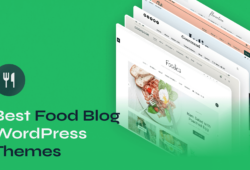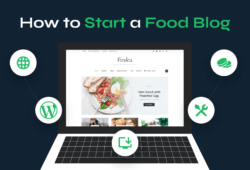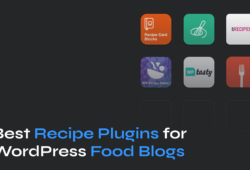
Are you passionate about cooking and eager to share your culinary creations with the world? Food blogging offers a unique opportunity to turn that passion into a profitable venture. While the food niche is competitive, the rewards are substantial for those who create high-quality content and build a dedicated community.
This guide will show you how to make money as a food blogger, exploring various monetization methods like display ads, affiliate marketing, online courses, and cookbooks. Join the growing community of food bloggers turning their love for food into a thriving business.
How Much Do Food Bloggers Make?
So, how much can you make as a food blogger? The earnings can vary significantly, from nothing at all to millions per month for the most successful bloggers. To give you an idea of the potential, here are some inspiring examples of food bloggers who have successfully monetized their blogs:
- Tiffy Cooks, a popular food blogger, earned an impressive monthly income of between $45,000 and $55,000 in 2021.
- The Clean Eating Couple reported an annual income of $150,000 in 2019.
- In early 2022, Stephanie’s Sweet Treats showed earnings ranging from $4,000 to $9,000.
- The Midwest Foodie Blog earned over $60,000 in income in just the first quarter of 2022.
- Pinch of Yum stands out as a prime example of what’s possible in the world of food blogging. It earned $90,000 monthly in 2019 and soared to $10.5 million in 2021.
- A Sassy Spoon has a steady monthly income of around $7,000.
Food Blogger Salary
If you’re considering becoming a food blogger to get paid and prefer a salaried position rather than starting your own blog, it’s important to have realistic expectations about potential earnings.
According to ZipRecruiter, the average food blogger’s salary in the US is $62,275 per year as of January 31, 2024.
This average salary provides a general idea of what to expect, but keep in mind that actual earnings can vary widely. Factors such as experience, location, and the specific employer can significantly influence your salary as a food blogger.
How to Make Money as a Food Blogger
If you’re new to the world of blogging, you might be unsure where to start to make money as a food blogger. Fortunately, there are numerous revenue streams to explore. While the most successful blogs often utilize multiple income sources, beginners can start with just a few key methods to begin generating income.
1. Display Ads on Your Food Blog
Display advertising is one of the most common ways to make money as a food blogger. While it’s straightforward to set up display ads on a WordPress blog, significant income generally requires a high volume of traffic.
Display ads are designated areas on your website that feature text and image links promoting other websites. Ad networks handle the setup and manage payments based on clicks or impressions.

The most accessible ad network for beginners is Google AdSense. After signing up, you add a few lines of code to your website, and Google will display relevant ads. You’ll receive a tracking ID to monitor clicks and revenue. While there are no minimum traffic requirements to join, you’ll need an established blog with high-quality content for approval.
As your blog traffic grows, consider transitioning to higher-paying ad networks like Mediavine or AdThrive. These networks partner with large brands and offer better rates for ad placements. They have specific acceptance requirements, typically including a minimum monthly traffic volume.
To boost your income further, some ad networks allow video ads in addition to traditional text and image ads. Incorporating video ads can enhance user engagement and increase your earnings.
By strategically placing display ads and gradually moving to premium ad networks, you can effectively monetize your food blog and generate a steady income.
2. Selling Ad Space Directly
To maximize your advertising income, consider selling ad space directly to businesses instead of relying on an ad network.
The advantage of this approach is that keep all the revenue generated from ads, avoiding ad network commissions. You also have full control over the types of ads displayed on your site.
However, to identify potential advertisers, negotiate prices, and upload ads yourself. In addition, most businesses prefer to buy ad space from blogs with high traffic and strong reader engagement.
To get started, create a page on your site that includes details of the available ad packages, traffic stats, and contact information. You can also compile a list of potential advertisers and contact them directly.
While you’ll need a substantial traffic volume and a good reputation to attract advertisers, selling ad space directly allows you to command significantly higher rates. Free plugins like Advanced Ads make it easy to add and manage ads on your WordPress blog, streamlining the process.
3. Affiliate Marketing
Affiliate marketing is a powerful way to make money with a food blog without cluttering your site with ads. It involves promoting products or services and earning a commission for every sale made through your unique affiliate links.

Let’s say that you have a recipe on your site for pancakes and recommend a certain whisk in your recipe description because you’ve found that it produces the perfect batter consistency. If a reader then clicks your affiliate link and buys that whisk from Amazon or another online retailer, you’ll receive a small commission for your endorsement.
Amazon Associates is an easy entry point due to Amazon’s vast product selection and trusted brand. Sign up, use special links in your content, and start earning commissions.
To start making affiliate commissions with Amazon, simply sign up as an affiliate and use a special link every time you link to a product there. Your commissions will be calculated automatically, and you can cash out as soon as your balance reaches a certain level.
You can also sign up for other affiliate programs. Many retailers use a third-party affiliate program like ShareaSale, Pepperjam, or CJ.com to find affiliates for their products, while a few offer their own direct affiliate programs.
Don’t limit yourself to physical products. Promote digital services such as WordPress hosting, online courses, and software tools relevant to your audience.
By thoughtfully integrating affiliate marketing into your content, you can provide value to your readers while generating a steady income.
4. Sell Recipe Books & E-Books
Selling recipe books and e-books is a fantastic way to monetize a food blog, especially if you have a dedicated audience. This approach allows you to showcase your culinary expertise and create a product that your readers will love. You can earn money directly from sales without relying on ads or affiliate commissions and establish yourself as an authority in the food blogging niche.
Start by compiling your best recipes into a well-organized cookbook, which you can sell as an e-book or even a physical book. Additionally, consider writing e-books on topics like kitchen organization, food blogging tips, or food-themed fiction.
Platforms like Amazon and Kobo make self-publishing easy. With print-on-demand services, you can offer physical books without upfront costs. Alternatively, use your food blog to sell e-books directly to your audience, maximizing profits and allowing for direct engagement with your readers.
By creating and selling recipe books and e-books, you can turn your culinary passion into a tangible product that generates income and strengthens your brand.
5. Sponsored Posts & Brand Deals
Sponsored posts and brand deals are lucrative ways to make money as a food influencer. By collaborating with brands, you can create content that promotes their products while earning a fee or receiving free products.
Sponsored posts involve writing blog content that features a brand’s product or service. Brands might pay you to write a post or provide you with complimentary products to use in your recipes. These posts can be a one-time arrangement or part of a broader brand deal.
Brand deals, or ongoing partnerships, often involve regular mentions of the brand in your blog posts and social media. As a brand ambassador, you can earn thousands of dollars by promoting a single product or company multiple times per year.
To start, build a modest following or blog traffic and gradually increase your rates as your influence grows. Contact brands directly or join influencer marketing agencies to find opportunities. While agencies take a cut of your fees, they handle finding deals and negotiating rates, simplifying the process.
6. Create an Online Course
If you have a specific skill or niche knowledge, such as baking or gluten-free cooking, you can create a course that offers value to your audience.
Start by outlining your course content. Decide whether your course will be a simple eBook or a more interactive experience with video lessons, quizzes, and other engaging elements. Platforms like Teachable and Udemy allow you to create and sell courses easily, offering tools to include videos, quizzes, and interactive features.
On Teachable, you can set your own prices and have full control over your course content, though there are monthly fees and transaction charges. Udemy, on the other hand, often features lower-priced courses and takes a share of your revenue, but doesn’t charge upfront fees.
Alternatively, you can use a WordPress LMS (learning management system) plugin to host your course directly on your blog, giving you complete control over the pricing and delivery.
Creating a high-quality online course requires time and effort, but it can be a very profitable way to monetize your food blog. Charge a fair price for in-depth courses, and consider offering smaller, focused courses on specific skills to appeal to a wider audience.
By offering an online course, you not only generate income but also establish yourself as an authority in your niche, providing valuable education to your readers.
7. Develop an App
If you’ve already published a successful cookbook, you might want to consider developing an app to accompany it.
A recipe app, for instance, can offer interactive content, videos, and easy access to your recipes, enhancing the user experience.
You can monetize your app in several ways. Charge a one-time fee for download, offer in-app purchases, or set up a subscription model for access to premium content and updates. Free apps can also generate revenue through in-app advertising.
Building an app can be complex and costly if you hire a developer, but no-code app-building platforms offer a more affordable and manageable alternative. These platforms provide drag-and-drop tools that allow you to create an app without needing to learn programming.
If you already have a successful cookbook, consider developing a companion app. This can expand your reach and provide additional value to your readers. Regular updates and new content will keep your audience engaged and willing to pay for your app.
8. Sell Merch & Physical Products
Once you have a dedicated audience, you can create branded items that resonate with your followers.
Consider selling branded merchandise such as aprons, tote bags, or clothing with your blog logo. These items can help promote your brand while providing value to your audience. Additionally, you could develop your own line of kitchen equipment, tableware, or even specialty ingredients that align with your blog’s theme.

To get started, use print-on-demand services, which allow you to create and sell products without upfront costs. These services handle production, shipping, and fulfillment, making it easier to manage your inventory.
Partnering with existing brands to create co-branded products can also be a lucrative option. For example, lifestyle blogger Joy Cho has released several collections with Target, including party decor and kitchen supplies.
9. Create a Membership Site
Creating a membership site is an excellent way to generate a steady income from your most dedicated readers. By offering exclusive content, you can provide additional value to your audience and build a community of loyal followers.
A membership site can include various types of exclusive content, such as new recipes, detailed cooking tutorials, meal plans, or behind-the-scenes content. You can charge a monthly or annual fee for access, providing you with recurring revenue.
If your blog is hosted on WordPress, several membership plugins, such as MemberPress, allow you to easily set up and manage your membership site. These plugins enable you to password-protect specific sections of your site or individual posts.
Alternatively, you can use external platforms like Patreon, Buy Me a Coffee, or Memberful to offer membership options. These platforms handle the technical aspects of subscription management, making it easier to focus on creating content.
To attract members, promote your membership site on your blog and social media channels, highlighting the exclusive benefits and content they will receive. Offer limited-time discounts or special promotions to encourage sign-ups.
10. Advertise Your Freelance Services
Many bloggers earn additional income by providing services such as recipe development, food photography, content writing, and social media management.
Determine the skills that set you apart. If you excel at food photography, you can offer your services to other bloggers, restaurants, or food brands. If you have a knack for writing, consider offering content creation or blogging services.
Add a dedicated services page to your blog. Outline the services you offer, your experience, and any relevant examples of your work. Include testimonials from satisfied clients if you have them.
Use your blog and social media channels to promote your freelance services. Regularly share updates and examples of your work to attract potential clients. Networking within the blogging community can also help you find freelance opportunities.
Research market rates for the services you offer and set your prices accordingly. Be transparent about your rates on your services page to attract serious inquiries.
Freelancing isn’t strictly making money directly from your blog, but it’s a great way to leverage your blog’s audience and brand to make some extra money on the side.
11. Coaching & Consulting
Similarly, several successful food bloggers have turned their passion into a profession by offering coaching and consulting services to people seeking advice on blogging, food photography, recipe development, or marketing.
The difference between offering coaching or consulting services and freelancing is that you can usually command much higher rates, and you’ll typically offer your services on a limited basis. This is because people pay for your knowledge and advice rather than a specific service like writing or photography.
Not everyone is cut out to be a coach or consultant, but if you feel like you have a lot of knowledge and advice to share, this could be a great additional income stream for your food blog.
Start a Food Blog and Make Money Today
These are just a few ways to start a food blog and get paid. New monetization possibilities are popping up all the time, so the sky really is the limit when it comes to how much you can make from your blog.
Do your research, try out a few different methods, and see what works best for you and your audience. There’s no “right” or “wrong” way to make money from a food blog. As long as you provide value and create content that people want to read, you can be creative and find a monetization strategy that works for you.
If you haven’t started your food blog yet, there’s no better time than now. Follow this simple step-by-step guide to starting a WordPress food blog and take it from there. This time next year, you could be making a killing in the kitchen.










February 18, 2023 12:20 am
Totally incorrect. My clients (all food bloggers) make WELL into six figures and NO ONE sells ad space, or writes cookbooks, or most of what you’ve said here. They make quality content; join an ad network or two; monetize their youtube and Facebook videos. Voila! Bank.
December 2, 2023 6:40 pm
Hi Jenn,
I used to Chef for a living when I was younger and I currently have a catering company that is doing very well. But I think that I may be missing something. Lots of people in my network. Tell me that the things that I know in regards to how to handle food and kitchens, etc., not everyone is aware of these type of things. I would like to start some type of a blog to help people with simple practices in the kitchen and possibly some menu, instruction and things similar to that. What would I do to take my first step in this endeavor? Thank you so much .
Gerry
February 21, 2023 9:01 am
Hi Pavel
My name is Rick Marzan
I started a food blog 10 months ago. I work at it everyday, adding 1 to 2 blogs a week.
So far I have not made a cent.
Any advice.
Thanks